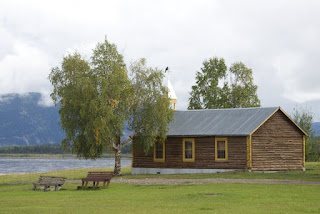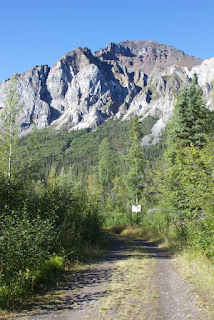 |
| Eagle, Alaska from Yukon River |
Our first visit to Eagle, Alaska, was during last year’s
(2014) trip. This small town at the top
of the world has become one of our favorite towns in Alaska. The people are warm and friendly, the scenery
picturesque, and it is far from the tourist crowd. We stay at the BLM campground, nestled deep
in the forest of pines and tundra. The
campground averages three campers per day this year, up from just two last
year.
Eagle now boasts a restaurant, compliments of the Eagle
Trading Company’s new venture to add 48 motel rooms, a general store, and
restaurant. During the 2009 flood, the
restaurant and original ten-room motel washed away. Although the motel was not yet open, the
restaurant served a fine breakfast with quality food and good prices for such a
remote area. The new motel will join the
Falcon Inn B&B as places to stay in Eagle.

The town of Eagle rests at the end of the Taylor
Highway, some 161 from the Alaska Highway and 94 miles north of Chicken, Alaska. The road between Chicken and Eagle is
entirely gravel, passable with two-wheel drive, and seems well maintained. With beautiful scenery the entire route, the Taylor Highway winds through some high ridge roads
and down through deep canyons. Some
areas have tight curves with steep cliffs on one side and drop offs on the
other, which can be particularly intimidating to some, particularly those
driving large rigs. Between mid-October
and April, the road to Eagle is closed and the town is accessible only by
plane.
 |
| View from Taylor Highway, Alaska |
 |
| Rim road on Taylor Highway, Alaska |
Eagle includes about 100 residents, most of them full timers
(those who stay all year long). The new
community school has 21 children enrolled this year. The town is powered by a community
generator. It also has a community well
where most folks fill great water holding tanks since few of the houses have
running water.
 |
| Courthouse, Eagle, Alaska |
 |
| Restored church overlooking Yukon River, Eagle, Alaska |
We arrived in Eagle on a Saturday so were able to join
worship service at the Eagle Bible Chapel on Sunday morning.
We were so surprised to be greeted by their
wonderful band playing praise music as folks mingled until service began.
The band included a flute, trumpet, mandolin,
piano, bass guitar, and three acoustic guitars.
They played old hymns that I grew up with as a child.
I admit when they played
In the Garden, it was hard to hold back tears.
We have sung that hymn at almost all of our
immediate family funerals.
The church had about 30 worshipers this day. After the service, many stopped to chat with
us, including Steven, the gentleman who gave us our tour of Eagle’s museum and Fort
Egbert last year. It felt like we were
coming home… the rare gift of a small town.
How wonderful!
After church, we visited the new Eagle Trading Company restaurant
for breakfast and were allowed to peek into several of the yet unfinished motel
rooms. These rooms will probably be open
to guests next year. Then we drove out
to the Han tribal community, several miles out of town. The original tribal settlement had been
demolished during the flood of May 2009.
It was completely rebuilt on higher ground with the help of both Mennonite
and Billy Graham-backed relief efforts.
Monday, after a visit to the Yukon-Charley Rivers National
Preserve Visitor Center and some pointers from Ranger Chris on gold panning, we
decided to try our luck panning on Jack Wade Creek, just down the road from our
campground. This section of water is
open to anyone to pan for gold (unless there is evidence of mining equipment in
the area). I decided quickly that I
never would have made it during the gold rush… the water was too cold, quickly
numbing fingers, and the pickings too slim.
We certainly didn’t find that life-changing nugget while sifting through
the silt!
Last year the campground was covered in a wide variety of
wild mushrooms that we had never before seen.
It had been drier this year, so the proliferation of mushrooms was much
less. The rain, however, caught up with
us yet again. By the time we departed,
more mushrooms began to pop up in the moss-covered, spongy tundra, including
the rare bleeding mushroom.
In the afternoon we took the Pipeline Trail, which meanders from
the campground along Fort Egbert’s original water pipeline. The pipeline provided water to the fort from
a small stream near the creek. A boiler
house pumped the water uphill while warming houses kept the water from
freezing.
The trail ended on top of the small, grass runway that
overlooks the Visitor Center and the Yukon River. We both looked up, laughing, remembering last
year’s experience. The runway landing is
right over the road to the campground, complete with cautionary signs.
 |
| View from end of Pipeline Trail, Eagle, Alaska |
Last year as we were strolling along Fort Egbert’s historic
grounds, we both instinctively ducked as a small blue plane came in low and
sideways over the hill, attempting to make a landing amidst a fierce crosswind
on this short field. At first it seemed
as if he wouldn’t make it. The plane
looked catywampus and in dire need of altitude.
His touchdown, however, was perfect… a testament to a true Alaskan bush
pilot … his years of experience obvious.
We have since learned that the pilot is over 80 years old and has been
flying since he could walk. Here is a
photo from last year’s adventure to give you an idea of his approach…
 |
| An Alaska bush pilot lands in Eagle... road to campground in extreme lower-right corner! |
Fall colors have begun to bathe the
mountainsides, becoming more and more brilliant each day. We awoke to sunshine and bid a fond farewell
to Eagle and its wonderful townspeople, vowing to return. Today, however, the Dempster beckons, and we
must go!
 |
| Taylor Highway, Alaska |
























